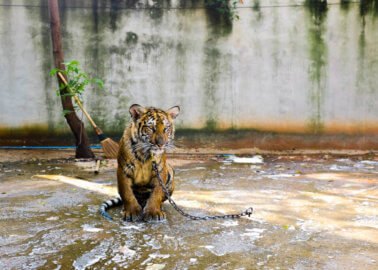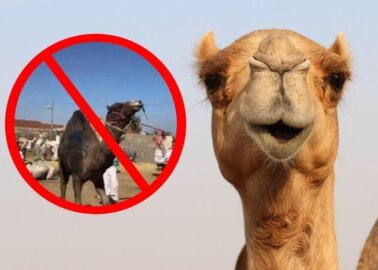17 Reasons Why Camel Rides Are Unethical and Cruel
Whether you’re planning a trip to Australia, Egypt, Jordan, Morocco, the United Arab Emirates, or anywhere else in the world, always stay away from camel riding and camel trekking.

Used to score money from tourists, camels exploited for rides are abused, threatened, beaten, and killed. Handlers control them by depriving them of food, put them in restraints, brand them, and artificially inseminate them. When you see camels used for tourist rides, remember that they’re often forced to comply through violence and fear. Here’s what tour operators aren’t telling you about camel rides:
1. Camels Are ‘Broken’ Into Submission
In a series of three articles published on the travel website So Morocco, a camel trainer named Mohamad El Gasmi describes traditional training practices. Training can begin when camels are 2-and-a-half years old, he says, and the first step is to break the animal’s will. Trainers commonly dominate camels by knocking them to the ground and pinning them down while another trainer ties them up.

2. Camels May Be Starved as Part of ‘Training’
Camels are starved and restrained as part of traditional training. Trainers also tie them to a tree or other object, where they can’t see any other humans, and don’t feed them for an extended period to break their spirit.

3. Ropes Hurt Camels’ Delicate Noses and Mouths
Trainers put ropes and sticks through camels’ sensitive noses – pushing them directly through the tender tissue of their nostrils – to lead them around for tourist rides and force them to comply through pain. Can you imagine having a 10-centimetre-long stick inserted into your nose? They also tie their lower jaws so they can control the animals’ movements. Camels are known to have weak jawbones, and tying ropes around them can cause serious health problems. Videos posted by travel vloggers of a camel ride through the Sahara Desert show camels with ropes painfully tied around their lower jaw.

4. Handlers Tie Camels’ Legs
Hobbling camels by tying their legs together to restrict their movement is also part of “training”. A guide to training camels by Farm Africa and the Kenya Network for Draught Animal Technology says, “Sometimes a recalcitrant camel has to be fought to obedience.” A PETA Asia investigation into Birqash Camel Market, the chief supplier of camels to the Egyptian tourism industry, also shows the animals’ legs tied tightly together to prevent them from moving or escaping and reveals that some camels are tied to the backs of vehicles and dragged through the dirt.

5. Camels Are Beaten With Wooden Sticks
In a BBC video featuring camel training methods, a camel is hit with a wooden stick to force him or her to accept a rider, while an investigation by PETA Asia into camel rides in Egypt showed that the animals were severely beaten on the testicles and in the face with sticks, leaving them with bloody wounds. They did not receive any veterinary treatment.

6. Handlers Chain and Muzzle Camels
Africanews revealed in a video segment that camels may be chained up or muzzled when forced to give tourist rides in the Sahara, because some animals spit or bite out of fear. The segment explains that it takes six to eight years for a camel to mature, but camels under 4-and-a-half years old are often used for camel riding, which impacts their bone growth.

7. Painful Wounds Go Untreated
Tourists have reported seeing camels with metal straps placed around their head to ensure they hold it up. These straps can cause painful wounds due to friction and being poorly fitted. Tourists have also observed camels being controlled with hooks and pegs. In Petra, Jordan, a PETA Asia eyewitness saw camels forced to work with fly-infested open wounds. The PETA-supported veterinary clinic in the area reports that camels often suffer from malnutrition, foot injuries, abscesses, skin conditions, anaemia, painful saddle sores, and lameness. Some have been deliberately cut with razor blades, stoned, or tasered, and most have never seen a veterinarian in their lives. And camels at the pyramids of Egypt are forced to give tourists rides while they’re injured or exhausted.

8. Camels Are Electrocuted in the Anus to Force Ejaculation for Breeding
In nature, camels live in herds and will choose when and with whom to mate. When exploited by humans, they are denied the opportunity to engage in this behaviour. Camel breeders now use electroejaculation to collect semen and artificially inseminate females. This painful procedure involves restraining the bull camel with ropes and electrocuting him using an anal probe to force ejaculation. According to a study of these procedures, “the use of electro-ejaculation for semen collection does not respect animal welfare” and can injure camels and induce fear.

9. Baby Camels Are Branded With Hot Irons
Baby camels are commonly branded with red-hot irons, causing immense pain. Other methods include tattooing the animals’ sensitive inner lips and tagging their ears.

10. Camels Endure Stress
Camels feel stress and pain. A leading expert on camel welfare, Professor Mohammed El Khasmi of the University of Hassan II in Casablanca, Morocco, has been quoted as saying that research has shown that camels are “very sensitive to physiological factors such as deprivation of water and food, environmental variables, physical treatment and pathological stress”.

11. Camels Are Killed When No Longer Profitable
There’s no retirement for camels exploited for tourism. When their bodies are too worn out to be used for rides, they’re usually sold to be killed for meat. If you’ve ever ridden a camel, there’s a high chance that he or she has already been slaughtered.
12. Camels Die in Agony and Terror
In abattoirs, camels may be killed with axes or metal bars. Footage from Saudi Arabia shows camels covered in blood groaning while they are repeatedly hit in the face and neck. This video from Mongolia shows the terrifying last moments of a camel who was exploited for rides:
13. Tourists Are Risking Their Life and Health
Travellers have been advised not to touch camels after two people in Saudi Arabia died from Middle East respiratory syndrome (MERS). MERS is a coronavirus that occurs in 27 countries across Africa, the Middle East, and South Asia. It has killed over 900 people and is transmitted to humans primarily from dromedary camels. Tourists are at risk of contracting zoonotic diseases from camels and sustaining injuries from being kicked or bitten or falling during rides. This is also one of many reasons never to consume camel milk or products containing it.

14. ‘Welfare’ Standards Do Little for Camels
No matter what “high welfare” claims providers are making, there is no way to ride a camel without exploiting him or her. Audits or monitoring often only take place a few times a year and do little to solve the problem of camel abuse. While sometimes well-meaning, animal welfare standards can actually perpetuate camel abuse in tourism by allowing camel owners to continue operating if they agree to just a few small changes.

15. Children Are Involved in Camel Abuse
In Egypt, even children were observed viciously beating camels with sticks, causing one victim to foam at the mouth and others to scream in pain. Following this investigation, three people were arrested on suspicion of torturing camels at Birqash Camel Market in Cairo. Child labour is also used in the animal-ride trade in Petra, Jordan.

16. Riding Camels Is Speciesist
We simply have no right to exploit anyone for entertainment. Camels are individuals with unique personalities: they greet their friends by blowing into their faces, love their families, feel pain and fear just like we do, and are not ours to exploit in any way. The fact that camels are a different species doesn’t mean humans can use them as they please. Camels used for tourist rides or experiences in Australia, Egypt, Jordan, Morocco, Tenerife, the UAE, and everywhere else in the world are denied everything that is natural and important to them. All aspects of their life are controlled by humans – none can run free with their herd or choose where to graze or with whom to mate.

17. There Are Other Ways to Explore Deserts
With so many other ways to explore deserts, there is absolutely no need to exploit camels for tourist rides. From dune-bashing expeditions in 4×4 vehicles, quad biking, and fat-bike tours for those who are feeling adventurous to learning to sandboard and watching a desert sunrise from a hot air balloon, there are numerous ways to experience majestic deserts and make memories without harming any animals.

What You Can Do for Camels
- Avoid all rides, tours, photo opportunities, and other experiences involving camels and other animals.
- Share this blog and PETA’s videos with your friends and family and urge them never to ride a camel.
- Whenever you see someone has posted a picture of a camel ride on social media, get in touch and politely explain that camels are beaten and threatened into submission. Show them PETA’s videos and urge them never to ride camels again.
- If you see a tour operator promoting such activities, please get in touch and ask them to stop.
- Please also use our rapid action page to help end animal exploitation for tourist rides around the globe:



